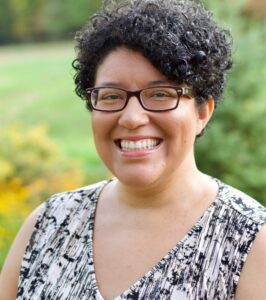Summary:
Kekla Magoon is an author of young-adult fiction, historical non-fiction, and a member of the NWP Writers Council.
Originally published on May 21, 2014
The most common question I get asked by children and adults alike is, “What’s your inspiration?” This query has many close cousins: “Where do you get your ideas?” “Why do you write for children?” “What made you write a book about a certain topic?”
There is nothing wrong with these questions, except that there is no succinct way to respond. Such wonderings seem so simple, but in reality are powerful and deep. In a time and place where people seem hungry for answers and for easily-digestible soundbites, I often find myself floundering for a way to touch the truth of these issues within the space of a conversation. Because, frankly, my entire job as a writer is to transform my ideas and inspirations into words. This effect takes hours, days, or years to achieve—and the result is never a simple soundbite. It’s a book, a story, a scene, a narrative that most likely speaks its truth slantwise.
What inspires me? Things I see. But such a simple phrase cannot encompass what it means to glance across a room and see a mother lovingly brush her child’s hair back off his cheek, and upon witnessing this, come to know one of my characters a bit better.
Where do I get my ideas? Sometimes straight out of my experience. But that statement doesn’t adequately explain the process of turning my own childhood fears, insecurities, and doubts into a novel like Camo Girl. Ella, the main character in that book, is not me at all, yet she feels the way I felt many times as a young person navigating my friendships.
Why do I write for children? Because the characters that come out of me are often very young. Yet, that assertion cannot fully capture my feelings about my amazing audience of young readers, who approach each page with open wonder, who challenge me to be my best, who look me in the eye and tell me the truth about everything. I can’t ever fully explain why I choose to explore my childhood self in my writing, or how I see that young self reflected in my characters and even in my readers.
What makes me write about certain topics? My own creative hunger to learn and to touch things unknown. I started work on The Rock and the River—a novel about two brothers exploring the Black Panther Party in 1968 Chicago—because I wanted to imagine what it felt like to exist in that moment in time and have to make a choice about where you would stand, and what you would stand for. I became motivated to finish and publish the book because I recognize that my young readers and I still face such choices today, though circumstances have changed.
When the world requires succinct answers of me, I can give them. But I always try to leave space for people to read more deeply into those answers, if they are willing. When I speak to groups of young readers, I tell them simply: There are two reasons why I write. First, I write to express myself and to share the things I know a lot about. Second, I write to learn and explore things I know very little about. Almost always, in response, the students nod silently. And then they keep on listening. Instinctively, they understand. There is always more to say.


